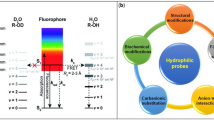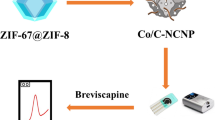Abstract
A novel nanomaterial of two-dimensional holey CuCo2O4 (2D HCCO) nanosheets was synthesized via a general template-directed method and employed for the first time to construct an effective electrochemical platform for H2O2 sensing with the combination of cerium oxide (CeO2). During the electrocatalytic reduction of H2O2, the synergetic catalysis of CeO2/HCCO/MWCNTs/GCE owing to the naturally holey frameworks and the mediator of CeO2 results in the ultra-sensitive detection of H2O2. The current was greatly enhanced owing to the unique holey structure that can minimize the charge transfer distance and provide more active sites to boost the signals, and the dual oxidation state of Ce3+/Ce4+ on the surface of 2D HCCO nanosheets can promote the in situ production of Cu2+/Cu+ and Cu+/Cu and further amplify the detection signal. The CeO2/HCCO/MWCNTs/GCE showed a wide linear range from 1 μM to 7.31 mM using chronoamperometry at the potential of − 0.25 V and a relatively low detection limit of 0.16 μM in physiological environment, which was also utilized for tracking the trace H2O2 released from Hela cells. This study shows great promise for the emerging application of holey HCCO-based biosensors in bioanalysis and early cancer diagnosis.

Graphical abstract





Similar content being viewed by others
References
Lopez-Lazaro M (2007) Dual role of hydrogen peroxide in cancer: possible relevance to cancer chemoprevention and therapy. Cancer Lett 252:1–8
Arnold RS, Shi J, Murad E, Whalen AM, Sun CQ, Polavarapu R, Parthasarathy S, Petros JA, Lambeth JD (2001) Hydrogen peroxide mediates the cell growth and transformation caused by the mitogenic oxidase nox1. PNAS 98:5550–5555
Lennicke C, Rahn J, Lichtenfels R, Wessjohann LA, Seliger B (2015) Hydrogen peroxide - production, fate and role in redox signaling of tumor cells. Cell Commun. Signal 13:19
Chang K, Liu Z, Fang X, Chen H, Men X, Yuan Y, Sun K, Zhang X, Yuan Z, Wu C (2017) Enhanced phototherapy by nanoparticle-enzyme via generation and photolysis of hydrogen peroxide. Nano Lett 17:4323–4329
Galaris D, Skiada V, Barbouti A (2008) Redox signaling and cancer: the role of “labile” iron. Cancer Lett 266:21–29
Reuter S, Gupta SC, Chaturvedi MM, Aggarwal BB (2010) Oxidative stress, inflammation, and cancer: how are they linked? Free Radic Biol Med 49:1603–1616
Lin MT, Beal MF (2006) Mitochondrial dysfunction and oxidative stress in neurodegenerative diseases. Nature 443:787–795
Reja SI, Gupta M, Gupta N, Bhalla V, Ohri P, Kaur G, Kumar M (2017) A lysosome targetable fluorescent probe for endogenous imaging of hydrogen peroxide in living cells. Chem Commun 53:3701–3704
Xu J, Zhang Y, Yu H, Gao X, Shao S (2016) Mitochondria-targeted fluorescent probe for imaging hydrogen peroxide in living cells. Anal Chem 88:1455–1461
Peng R, Si Y, Deng T, Zheng J, Li J, Yang R, Tan W (2016) A novel SERS nanoprobe for ratiometric imaging of hydrogen peroxide in living cells. Chem Commun 52:8553–8556
Ni Y, Liu H, Dai D, Mu X, Xu J, Shao S (2018) Chromogenic, fluorescent, and redox sensors for multichannel imaging and detection of hydrogen peroxide in living cell systems. Anal Chem 90:10152–10158
Gu X, Wang H, Schultz ZD, Camden JP (2016) Sensing glucose in urine and serum and hydrogen peroxide in living cells by use of a novel boronate nanoprobe based on surface-enhanced Raman spectroscopy. Anal Chem 88:7191–7197
Ramaraj S, Sakthivel M, Chen SM, Lou BS, Ho KC (2019) Defect and additional active sites on the basal plane of manganese-doped molybdenum diselenide for effective enzyme immobilization: in vitro and in vivo real-time analyses of hydrogen peroxide sensing. ACS Appl Mater Interfaces 11:7862–7871
Sun Y, Luo M, Qin Y, Zhu S, Li Y, Xu N, Meng X, Ren Q, Wang L, Guo S (2017) Atomic-thick PtNi nanowires assembled on graphene for high-sensitivity extracellular hydrogen peroxide sensors. ACS Appl Mater Interfaces 9:34715–34721
Dai H, Lu W, Zuo X, Zhu Q, Pan C, Niu X, Liu J, Chen H, Chen X (2017) A novel biosensor based on boronic acid functionalized metal-organic frameworks for the determination of hydrogen peroxide released from living cells. Biosens Bioelectron 95:131–137
Naveen MH, Gurudatt NG, Noh HB, Shim YB (2016) Dealloyed AuNi dendrite anchored on a functionalized conducting polymer for improved catalytic oxygen reduction and hydrogen peroxide sensing in living cells. Adv Funct Mater 26:1590–1601
Aziz A, Asif M, Ashraf G, Azeem M, Majeed I, Ajmal M, Wang J, Liu H (2019) Advancements in electrochemical sensing of hydrogen peroxide, glucose and dopamine by using 2D nanoarchitectures of layered double hydroxides or metal dichalcogenides. A review. Mikrochim Acta 186:671
Cheng TW, Feng CQ, Wu HM, He M (2020) A novel nonenzymatic electrochemical sensor based on double-shelled CuCo2O4 hollow microspheres for glucose and H2O2. J Alloys Compd 819:153014
Chirizzi D, Guascito MR, Filippo E, Tepore A (2016) A novel nonenzymatic amperometric hydrogen peroxide sensor based on CuO@Cu2O nanowires embedded into poly(vinyl alcohol). Talanta 147:124–131
He GW, Jiang JQ, Wu D, You YL, Yang X, Wu F, Hu YJ (2016) Int J Electrochem Sci:8486–8498
Baranik A, Sitko R, Gagor A, Queralt I, Margui E, Zawisza B (2018) Graphene oxide decorated with cerium(IV) oxide in determination of ultratrace metal ions and speciation of selenium. Anal Chem 90:4150–4159
Mo F, Xie J, Wu T, Liu M, Zhang Y, Yao S (2019) A sensitive electrochemical sensor for bisphenol a on the basis of the AuPd incorporated carboxylic multi-walled carbon nanotubes. Food Chem 292:253–259
Liang Y, Li YG, Wang HL, Zhou JG, Wang J, Regier T, Dai HJ (2011) Co3O4 nanocrystals on graphene as a synergistic catalyst for oxygen reduction reaction. Nat Mater 10:780–786
Wang H, Cui LF, Yang Y, Casalongue HS, Robinson JT, Liang YY, Cui Y, Dai HJ (2010) Mn3O4–graphene hybrid as a high-capacity anode material for lithium ion batteries. J Am Chem Soc 132:13978–13980
Chen PL, Yuan Y (2017) Two-dimensional holey Co3O4 nanosheets for high-rate alkali-ion batteries: from rational synthesis to in situ probing. Nano Lett 17:3907–3913
Zhang YX, Ding F, Deng C, Zhen SY, Li XY, Xue YF, Yan YM, Sun KN (2015) Crystal plane-dependent electrocatalytic activity of Co3O4 toward oxygen evolution reaction. Catal Commun 67:78–82
Liu L, Jiang Z, Fang L, Xu H, Zhang H, Gu X, Wang Y (2017) Probing the crystal plane effect of Co3O4 for enhanced electrocatalytic performance toward efficient overall water splitting. ACS Appl Mater Interfaces 9:27736–27744
Kuang M, Li TT, Chen H, Zhang SM, Zhang LL, Zhang YX (2015) Hierarchical Cu2O/CuO/Co3O4 core-shell nanowires: synthesis and electrochemical properties. Nanotechnology 26:304002
Xue S, Li Q, Wang L, You W, Zhang J, Che R (2019) Copper- and cobalt-codoped CeO2 nanospheres with abundant oxygen vacancies as highly efficient electrocatalysts for dual-mode electrochemical sensing of microRNA. Anal Chem 91:2659–2666
Rajamani AR, Sebastian P (2018) Novel nanostructured Pt/CeO2@Cu2O carbon-based electrode to magnify the electrochemical detection of the neurotransmitter dopamine and analgesic paracetamol. ACS Appl Nano Mater 1:5148–5157
Xie Y, Tu X, Ma X, Fang Q, Liu G, Dai R, Qu F, Yu Y, Lu L, Huang X (2019) A CuO-CeO2 composite prepared by calcination of a bimetallic metal-organic framework for use in an enzyme-free electrochemical inhibition assay for malathion. Microchim Acta 186:567
Wu P, Qian YD, Du P, Zhang H, Cai CX (2012) Facile synthesis of nitrogen-doped graphene for measuring the releasing process of hydrogen peroxide from living cells. J Mater Chem 22:6402
Lian M, Chen X, Lu Y, Yang W (2016) Self-assembled peptide hydrogel as a smart biointerface for enzyme-based electrochemical biosensing and cell monitoring. ACS Appl Mater Interfaces 8:25036–25042
Jiang X, Wang H, Yuan R, Chai Y (2018) Functional three-dimensional porous conductive polymer hydrogels for sensitive electrochemiluminescence in situ detection of H2O2 released from live cells. Anal Chem 90:8462–8469
Annalakshmi M, Balasubramanian P, Chen SM, Chen TW (2019) Enzyme-free electrocatalytic sensing of hydrogen peroxide using a glassy carbon electrode modified with cobalt nanoparticle-decorated tungsten carbide. Mikrochim Acta 186:265
Tavakkoli H, Akhond M, Ghorbankhani GA, Absalan G (2020) Electrochemical sensing of hydrogen peroxide using a glassy carbon electrode modified with multiwalled carbon nanotubes and zein nanoparticle composites: application to HepG2 cancer cell detection. Mikrochim Acta 187:105
Dong S, Xi J, Wu Y, Liu H, Fu C, Liu H, Xiao F (2015) High loading MnO2 nanowires on graphene paper: facile electrochemical synthesis and use as flexible electrode for tracking hydrogen peroxide secretion in live cells. Anal Chim Acta 853:200–206
Lu Q, Zhai Q, Dyson J, Gong S, Zhao Y, Ling Y, Chandrasekaran R, Dong D, Cheng W (2019) Real-time and in-situ monitoring of H2O2 release from living cells by a stretchable electrochemical biosensor based on vertically aligned gold nanowires. Anal Chem 91:13521–13527
Dang W, Sun Y, Jiao H, Xu L, Lin M (2020) AuNPs-NH2/Cu-MOF modified glassy carbon electrode as enzyme-free electrochemical sensor detecting H2O2. J Electroanal Chem 856:113592
Funding
This work was supported by the National Natural Science Foundation of China (21974042, 21645008, 21305042), Scientific Research Fund of Hunan Provincial Education Department (18A010), Science and Technology Department of Hunan Province (14JJ4030), the construct program of the key discipline in Hunan Province, and the Aid Program for Science and Technology Innovative Research Team in Higher Educational Institutions of Hunan Province.
Author information
Authors and Affiliations
Corresponding authors
Ethics declarations
Conflict of interest
The author(s) declare that they have no competing interests.
Additional information
Publisher’s note
Springer Nature remains neutral with regard to jurisdictional claims in published maps and institutional affiliations.
Electronic supplementary material
ESM 1
(DOCX 430 kb)
Rights and permissions
About this article
Cite this article
Xie, J., Cheng, D., Zhou, Z. et al. Hydrogen peroxide sensing in body fluids and tumor cells via in situ produced redox couples on two-dimensional holey CuCo2O4 nanosheets. Microchim Acta 187, 469 (2020). https://doi.org/10.1007/s00604-020-04389-2
Received:
Accepted:
Published:
DOI: https://doi.org/10.1007/s00604-020-04389-2




